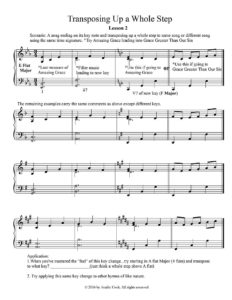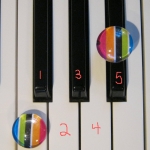Transposing Up a Whole Step: Lesson Two
Wednesday, August 24th, 2016 The skill of transposing is an extra plus for the church pianist if she or he is going to accompany someone to sing in their comfortable range…(another article) 😉
The skill of transposing is an extra plus for the church pianist if she or he is going to accompany someone to sing in their comfortable range…(another article) 😉
There is an art to finding just the right key for whomever you’re accompanying.
The following free pdf on Transposing Up a Whole Step will familiarize the church pianist on how to transpose up a whole step in a song of 3/4 time going into another song in 3/4 or the first song…different verse.
There are many factors to consider when creating a key change between two songs. For example, the first melody note of the second song determines the melodic direction of the key change.
Editor notes for Transposing Up a Whole Step: Lesson Two
- Play measures #1,2,3 and then start another verse of Amazing Grace on 3rd beat of measure #3
- Play measures #1, 2, and 4 and go right into Grace Greater Than Our Sin
Each line of this free pdf is identical to the first line except in different keys. Try finding hymns to use for the remaining lines of examples.
Variety tip: You can use this same transposition idea for a 3/4 hymn to a 4/4 hymn by holding the 3rd beat of the 3rd measure for 2 beats and then go into the 4/4 hymn IF the 4/4 hymn begins with a complete measure or at least the 4/4 hymn contains at least two beats at the beginning..in order for it to create a smooth sounding transition.
Clarification: The above transposition isn’t appropriate for congregational playing because of the additional measures used to create the key change. A shorter version would be necessary for congregational singing.
However…this transposition idea works great for offertories, preludes and accompanying instrumental or vocal special.
Click on following title for free pdf download: (Let me know if you’re having printing issues with this PDF. I think it’s just my printer but note sure..it seems my margins are wacky when it prints)
Transposing Up a Whole Step Lesson Two
Transposing Up a Whole Step: Lesson One (see chord structure for the above free pdf.


